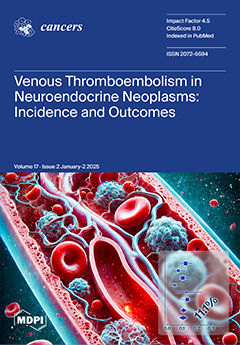Open AccessArticle
Comparison of Outcomes of Haploidentical Peripheral Blood Stem Cell Transplantation with Post-Transplant Cyclophosphamide in Older Versus Younger Patients
by
Giacomo Adoncecchi, Ambuj Kumar, Krishnakar Mogili, Rawan Faramand, Hien Liu, Farhad Khimani, Asmita Mishra, Michael Nieder, Taiga Nishihori, Doris Hansen, Michael Jain, Aleksandr Lazaryan, Lia Perez, Joseph Pidala, Frederick Locke, Claudio Anasetti, Nelli Bejanyan and Hany Elmariah
Viewed by 497
Abstract
Background: Previous studies have shown that allogeneic peripheral blood stem cell transplantation (PBSCT) from an HLA haploidentical (haplo) donor followed by graft-versus-host disease (GVHD) prophylaxis with post-transplant cyclophosphamide (PTCy) results in lower relapse rates and improved DFS when compared to haplo bone marrow
[...] Read more.
Background: Previous studies have shown that allogeneic peripheral blood stem cell transplantation (PBSCT) from an HLA haploidentical (haplo) donor followed by graft-versus-host disease (GVHD) prophylaxis with post-transplant cyclophosphamide (PTCy) results in lower relapse rates and improved DFS when compared to haplo bone marrow transplant (BMT) with PTCy. However, PBSCT leads to higher rates of GVHD. It is unknown whether the benefits of haplo PBSCT may be nullified in older patients (>60 years) by a higher susceptibility to GVHD and transplant related toxicity. Thus, we sought to determine if older patients receiving haplo PBSCT with PTCy experience significantly worse outcomes than younger patients. Methods: We evaluated 121 adult patients with hematologic malignancies treated at the Moffitt Cancer Center with allogeneic haplo PBSCT followed by PTCy and compared outcomes of patients ≥60 years (n = 55) versus patients <60 years (n = 66). Results: The cumulative incidence of non-relapse mortality (NRM) from the competing risk regression analysis was worse for the older patient group (SHR = 4.05, 95% CI: 1.43–11.47,
p = 0.008). However, there was no significant difference between groups in graft-versus-host disease (GVHD), relapse, disease-free survival (DFS), or overall survival (OS). Instead, hematopoietic comorbidity index (HCT-CI) ≥ 3 was associated with worse DFS (HR = 1.87, 95% CI: 1.04–3.34,
p = 0.035) and OS (HR = 1.98, 95% CI: 1.03–3.84,
p-value = 0.042). Subgroup analysis of patients ≥60 years showed a trend toward improved 2-year OS with fludarabine/cyclophosphamide/total body irradiation (Flu/Cy/TBI) versus fludarabine/busulfan: 71% versus 53% (HR = 0.47,
p = 0.121). In patients over 70 years (n = 14), NRM was 8% and OS was 76% at 1 year. Conclusion: Given similar OS and DFS between patients aged >60 years and those <60, haplo PBSCT with PTCy appears to be an appropriate transplant platform for older patients.
Full article
►▼
Show Figures






